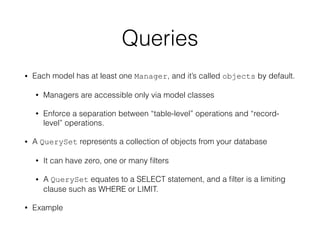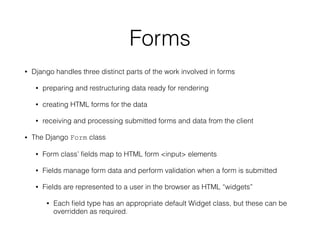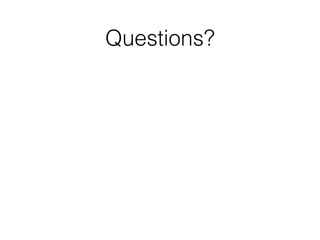Introduction to Python and Django
- 1. Introduction to (Python and) the Django Framework Prashant Punjabi Solution Street 9/26/2014
- 2. Python ! • Created by Guido van Rossum in the late 1980s ! • Named after ‘Monty Python’s Flying Circus’ ! • Python 2.0 was released on 16 October 2000 ! • Python 3.0 a major, backwards-incompatible release, was released on 3 December 2008 ! • Guido is the BDFL
- 3. Python • General Purpose, high-level programming language • Supports multiple programming paradigms • object-oriented, functional, structured, imperative(?) • Dynamically typed • Many implementations • CPython (reference) • Jython • IronPython .. and many more
- 4. The Zen of Python • “Core philosophy” • Beautiful is better than ugly • Explicit is better than implicit • Simple is better than complex • Complex is better than complicated • Readability counts • >>> import this
- 5. Data Types • Numbers • int, float, long (and complex) • Strings • str, unicode • Sequence Types • str, unicode, lists, tuples (and bytearrays, buffers, xrange) • strings, tuples are ‘immutable’ • lists are mutable • Mapping Types • dict
- 6. Functions • Defined using the keyword.. def • Followed by the function name and the parenthesized list of formal parameters. • The statements that form the body of the function start at the next line, • and must be indented (just like this line) • The first statement of the function body can optionally be a string literal • this string literal is the function’s documentation string, or docstring. • Arguments are passed using call by value (where the value is always an object reference, not the value of the object) • Functions always return a value • If not return is explicitly defined, the function returns None
- 7. Control Flow • if • if…elif…else • for • range • break, continue, else • while
- 8. Truthi-nessTM • An empty list ([]) • An empty tuple (()) • An empty dictionary ({}) • An empty string ('') • Zero (0) • The special object None • The object False (obviously) • Custom objects that define their own Boolean context behavior (this is advanced Python usage)
- 9. Modules and Packages • A module is a file containing Python definitions and statements. • The file name is the module name with the suffix .py appended. • Within a module, the module’s name (as a string) is available as the value of the global variable __name__ • Modules can be executed as a script • python module.py [args] • __name__ is set to __main__ • Packages are a way of structuring Python’s module namespace by using “dotted module names” • The __init__.py file is required to make Python treat a directory as containing packages
- 10. Classes • Python’s class mechanism adds classes with a minimum of new syntax and semantics • Python classes provide all the standard features of Object Oriented Programming • multiple base classes • a derived class can override any methods of its base class or classes • a method can call the method of a base class with the same name • Objects can contain arbitrary amounts and kinds of data • Class and Instance Variables • Static Methods
- 11. Standard Library • Operating System Interface • File handling • String pattern matching • Regular expressions • Mathematics • Internet Access • Dates and Times • Collections • Unit Tests
- 13. Django
- 14. Django • Django grew organically from real-world applications • Born in the fall of 2003, in Lawrence, Kansas, USA • Adrian Holovaty and Simon Willison - web programmers at the Lawrence Journal-World newspaper • Released it in July 2005 and named it Django, after the jazz guitarist Django Reinhard • “For Perfectionists with Deadlines”
- 15. Getting Started • Installation • pip install Django • ¯_(ツ)_/¯ • Creating a Django project • django-admin.py startproject django_example • Adding an ‘app’ to your Django project • python manage.py startapp music
- 16. MVC - Separation of Concerns • models.py • description of the database table, represented by a Python class, called a model • create, retrieve, update and delete records in your database using simple Python code • views.py • contains the business logic for the page • contains functions, each of which are called a view functions or simply views • urls.py • file specifies which view is called for a given URL pattern • Templates • describes the design of the page • uses a template language with basic logic statements
- 17. models.py • Each model is represented by a class that subclasses django.db.models.Model • Class variables represents a database fields in the model • A field is represented by an instance of a Field class eg CharField, DateTimeField • The name of each Field instance is used by the database as the column name • Some Field classes have required arguments, others have optional arguments • CharField, for example, requires that you give it a max_length • default is an optional argument for many Field classes • ForeignKey field is used to define relationships • Django supports many-to-one, many-to-many and one-to-one
- 18. Queries • Each model has at least one Manager, and it’s called objects by default. • Managers are accessible only via model classes • Enforce a separation between “table-level” operations and “record- level” operations. • A QuerySet represents a collection of objects from your database • It can have zero, one or many filters • A QuerySet equates to a SELECT statement, and a filter is a limiting clause such as WHERE or LIMIT. • Example
- 19. Migrations • New in Django 1.7 • Previously accomplished by an external package called south • Keeps the database in sync with the model objects • Commands • migrate • makemigrations • sqlmigrate • squashmigrations • Data Migrations • python manage.py makemigrations --empty music
- 20. urls.py • Django lets you design URLs however you want, with no framework limitations. • “Cool URIs don’t change” • URL configuration module (URLconf) • simple mapping between URL patterns (regular expressions) to Python functions (views) • capture parts of URL as parameters to view function (named groups) • can be constructed dynamically
- 21. views.py • A Python function that takes a Web request and returns a Web response • HTML contents of a Web page, • a redirect, or a 404 error, • an XML document, • an image • . . . or anything • The convention is to put views in a file called views.py • but it can be pretty much anywhere on your python path • ‘Django Shortcuts’ • redirect, reverse, render_to_response,
- 22. Templates • Designed to strike a balance between power and ease • A template is simply a text file. It can generate any text-based format (HTML, XML, CSV, etc.). • Variables - {{ variable }} • Replaced with values when the template is evaluated • Use a dot (.) to access attributes of a variable • Dictionary lookup, attribute or method lookup or numeric index lookup • {{ person.name }} or {{ person.get_full_name }} or {{ books. 1 }} • Filters can be used to modify variables for display • {{ name|lower }}
- 23. Templates • Tags control the logic of the template • {% tag %} • Commonly used tags • for • if, elif and else • block and extends - Template inheritance
- 24. Template Inheritance • Most powerful part of Django’s template engine • Build a base “skeleton” template that contains all the common elements of your site and defines blocks that child templates can override. • {% extends %} must be the first template tag in that template. • More {% block %} tags in your base templates are better • Child templates don’t have to define all parent blocks
- 25. Forms • Django handles three distinct parts of the work involved in forms • preparing and restructuring data ready for rendering • creating HTML forms for the data • receiving and processing submitted forms and data from the client • The Django Form class • Form class’ fields map to HTML form <input> elements • Fields manage form data and perform validation when a form is submitted • Fields are represented to a user in the browser as HTML “widgets” • Each field type has an appropriate default Widget class, but these can be overridden as required.
- 26. Batteries (still) included • Authentication and Authorization • Emails • File Uploads • Session • Caching • Transactions • .. and so on
- 27. See also.. • The Django ‘admin’ app • django-admin.py and manage.py • ModelForms • Generic Views or Class based views • Static File deployment • Settings • Middleware • Similar to Servlet Filters in Java
- 28. References • Python - Wikipedia page (http://en.wikipedia.org/wiki/ Python_(programming_language)) • The Python Tutorial (https://docs.python.org/2/tutorial/ index.html) • The Django Project (https://www.djangoproject.com/) • The Django Book (http://www.djangobook.com/en/2.0/ index.html) • The Django Documentation (https:// docs.djangoproject.com/en/1.7/)
- 29. Questions?
- 30. Thank you!







![Truthi-nessTM
• An empty list ([])
• An empty tuple (())
• An empty dictionary ({})
• An empty string ('')
• Zero (0)
• The special object None
• The object False (obviously)
• Custom objects that define their own Boolean context behavior (this is
advanced Python usage)](https://image.slidesharecdn.com/introductiontopythonanddjango-140926144805-phpapp01/85/Introduction-to-Python-and-Django-8-320.jpg)
![Modules and Packages
• A module is a file containing Python definitions and statements.
• The file name is the module name with the suffix .py appended.
• Within a module, the module’s name (as a string) is available as the value of the
global variable __name__
• Modules can be executed as a script
• python module.py [args]
• __name__ is set to __main__
• Packages are a way of structuring Python’s module namespace by using “dotted
module names”
• The __init__.py file is required to make Python treat a directory as containing
packages](https://image.slidesharecdn.com/introductiontopythonanddjango-140926144805-phpapp01/85/Introduction-to-Python-and-Django-9-320.jpg)




















